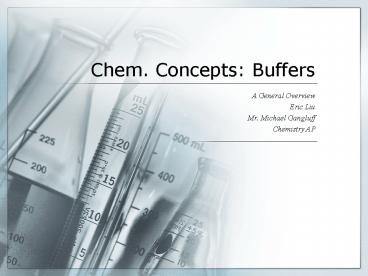Chem. Concepts: Buffers - PowerPoint PPT Presentation
1 / 7
Title:
Chem. Concepts: Buffers
Description:
Chemistry AP What is a Buffer ... shifting to the left or right to counterbalance the addition of acid or base Chem. Concepts: Buffers A General Overview Eric Liu ... – PowerPoint PPT presentation
Number of Views:140
Avg rating:3.0/5.0
Title: Chem. Concepts: Buffers
1
Chem. Concepts Buffers
- A General Overview
- Eric Liu
- Mr. Michael Gangluff
- Chemistry AP
2
What is a Buffer?
- A buffer is a solution that resists changes in pH
- when small amounts of acid or base are added to
it.
3
What is it made of?
Buffers can be placed into two categories acidic
buffers and basic buffers
- Acidic buffers
- Consists of a weak acid and a salt of its
conjugate base - e.g. CH3COOH and CH3COONa
- pH less than 7
- Basic buffers
- Consists of a weak base and a salt of its
conjugate acid - e.g. NH3 and NH4Cl
- pH greater than 7
Our blood is a buffer, as cells can only survive
within a narrow pH range
The pH of a buffer can be changed by altering the
ratio of acid and its conjugate base or base and
its conjugate acid. The amount of acid/conjugate
base or base/conjugate acid determine its buffer
capacity, or amount of acid or base that can be
added for it to still maintain constant pH
4
How does it work?
- Buffers follow one of the following equilibriums
- There are both products and reactants present in
both cases - Buffers use Le Chateliers Principle, which
states that a system will relieve stress put on a
system by shifting to the left or right side of
the equation accordingly. - In other words, if you add reactant to the
equilibrium, the system would respond by removing
reactant (and thus creating product), and vise
versa
5
How does it work?
If acid is added to the system
- The H3O from the acid will cause the system to
shift left - Or react with OH- to form H2O
6
How does it work?
If base is added to the system
- The OH- from the base will cause the system to
shift to the left - Or react with H3O to form H2O
7
Summary
- Buffers are solutions that resist changes in pH
with the addition of small amounts of acid or
base - They consist of a weak base and its conjugate
acid salt or a weak acid and its conjugate base
salt - They work through Le Chateliers Principle,
shifting to the left or right to counterbalance
the addition of acid or base































